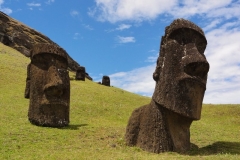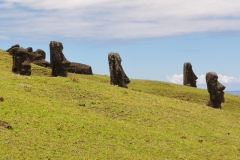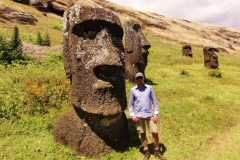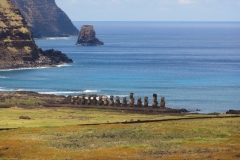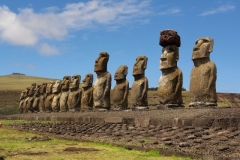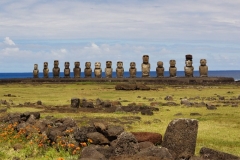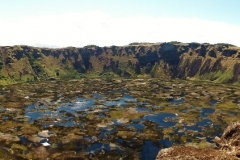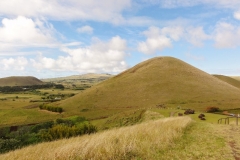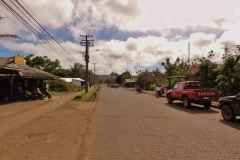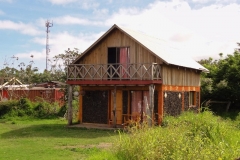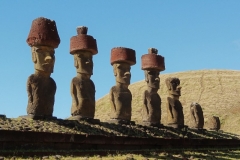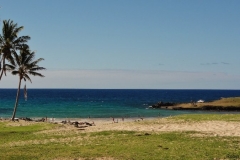Rapa Nui
One of the Remotest Inhabited Places on Earth

Before visiting Easter Island, I had not really realised quite how isolated it was. In fact, it is one of the remotest inhabited places on our planet.
Set in the south eastern part of the Pacific Ocean, the small triangular island lies over 3700km west of Chile and more than 2000km east of tiny Pitcairn Island (pop. 50). New Zealand is an incredible 7000km away.
Looking out of the plane window during the five-and-half-hour flight from the Chilean capital Santiago, all I could see was endless blue ocean. Easter Island really is a long way from anywhere.
Click on the pictures below for a description of each place.
At the little airport, a band played to welcome visitors, a group of locals in grass skirts swaying to the traditional Polynesian music. Easter Island may be part of Chile, but its culture is a blend of the Hispanic and its Polynesian roots.
The first inhabitants of the volcanic isle are thought to have sailed from other Polynesian islands far to the west. Local legend, though, has it that the settlers came from the east, led by King Hotu Matua.
This theory was supported by the Norwegian ethnographer Thor Heyerdahl who in 1947 sailed westward from South America in his balsa wood raft Kon Tiki to demonstrate that Polynesia could have been settled by the pre-Colombian inhabitants of South America. The oldest archaeological evidence dates from the early ninth century, but some experts think the first people arrived over four hundred years earlier.
Rapa Nui, as it is known in the local language, is only 24km by 12km and, as the population grew, so did the strain on natural resources. The result was cannibalism and wars between groups of rival clans from the east and the west of the island. Easter Island was once covered in forests of conifers and giant palms, but the locals gradually cut down nearly all the trees.
Until Europeans arrived, the Rapanui believed they were the last people in the world. The first European to visit was Jacob Roggeven of the Dutch East India Company, who landed there on Easter Sunday, 1722 and named it Easter Island.
In 1770, two Spanish ships stopped off and four years later the British Explorer Captain Cook visited. When the Europeans arrived, islanders were living in caves or long boat-shaped houses. In the 1860s, over half the island’s population of 3,000 was captured by Peruvian raiders and sold into slavery, including the king and the priests.
In 1870, Jean-Baptiste Dutroux-Bornier, a French adventurer, bought up most of the island and began importing sheep. Europeans brought smallpox and tuberculosis and by the late 1870s there were just 111 Rapanui left. Most of the indigenous culture and knowledge was lost forever, including anyone who could understand its unique pictographic writing known as rongo rongo.
In 1888, Easter Island became part of Chile with the island continuing as a sort of giant sheep farm until 1953. The indigenous population slowly recovered, but until the 1960s was confined to the capital Hanga Roa. Today, 60% of the people living on Easter Island are of Polynesian descent.
Eco-tourism is slowly developing and some 50 000 people visit here each year. Much of the island lies within the Rapa Nui National Park, in 1995 declared a UNESCO World Heritage Site in recognition of its special cultural status.
The island is famous for its monumental stone statues or moai. These iconic figures range in height from 2m to 20m. Built from basalt, they represented sacred ancestors who watched over their descendants in the coastal settlements in front of them, their backs toward the spirit world of the sea.
Moai were carved from rock using stone hand chisels. All moai come from a single site at the top of the extinct volcano Rano Raraku. The oldest were smaller and had round heads and round eyes. The best known are the later, larger ones with their elongated bodies, carved fingers, nostrils and long ears. Some moai have headdresses known as pukao, a large cylindrical piece of red stone mined from the small volcano Punapao. The pukao are thought to indicate special ritual status.
Some moai stood on ahu, ceremonial stone platforms which served as shrines. Others were lowered into holes dug in the ground.
How the stone age inhabitants of the island moved the moai from the hilltop quarries down to the coast is a mystery. One theory is that they used a sort of Y-shaped sledge.
The Ancestor Cult that inspired the carving of moai was eventually replaced by the Bird Man Cult.
The Bird Man Cult involved an annual competition to swim to the nearby islet of Motu Nui to collect the first Sooty Tern egg of the season. The winner – the Tangata Manu – was the first man to swim back to Rapa Nui with the egg and scale the precipitous cliff to the ceremonial village of Orongo at the top. In the season that followed, the winner’s clan had the exclusive right to collect seabird eggs and chicks.
The cult was practised until the 1860s when Christian missionaries suppressed it.
The remains of Orongo are just one of many interesting sites to visit on Easter Island. Today, new trees, such as eucalyptus, have been planted, but much of the landscape is grassland and looks surprisingly like parts of England. Country lanes wind across the undulating landscape where cattle and horses graze.
Most of the island’s population of 5800 live in the diminutive capital of Hanga Roa, little more than a sleepy village with a few shops and restaurants. Although there are farms on the island, only food flown in from the mainland can be served to visitors, ostensibly for health and hygiene reasons. This makes everything expensive. Strolling around the quiet streets, every now and then I heard the noise of someone chipping away at stone: making small reproduction moai is a booming business.
The island also has some lovely sandy beaches, with palm trees providing some welcome shade. The island is rather windy and temperatures are not as high as you might expect, but the sun is intense and a good sun cream is essential.
As I stood on the top of Rano Raraku, the warm breeze blowing in my face, I looked at the open sea extending in all directions as far as the eye could see. It was a strange feeling to realise I was on one of the remotest places on earth.
RETURN

